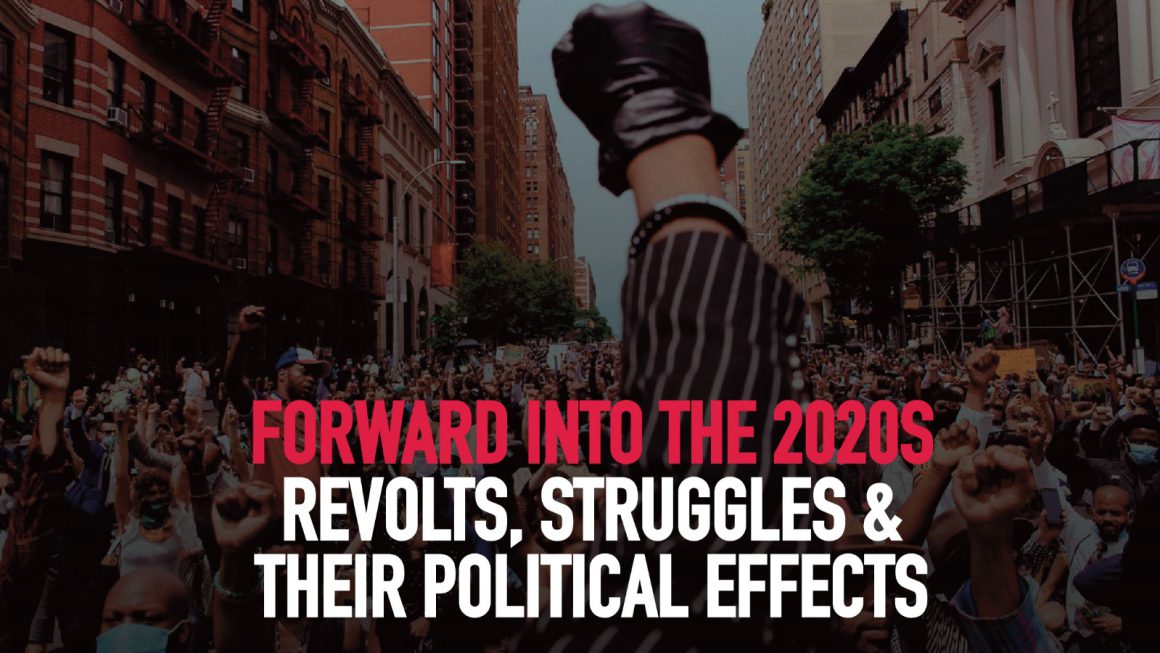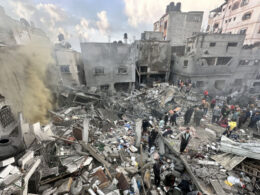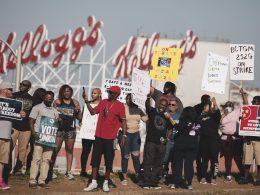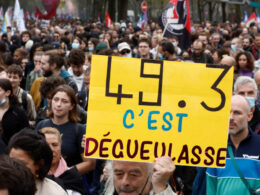The new wave of revolts and mass movements of 2019 continued in 2020 — despite the severe restrictions due to the pandemic and economic depression. From Thailand to Bolivia and Nigeria to Belarus, mass movements and protests have taken to the streets, challenging the ruling elites. What are lessons from these movements and what are the effects on consciousness? Read this article by Cedric Gerome and Per-Åke Westerlund of the International Executive of International Socialist Alternative (ISA). The ISA is the international revolutionary socialist organisation to which the Socialist Party is affiliated to.
Last year ISA, in its analyses, pointed out the new features of many mass movements — they lasted longer and rapidly became focused against governments with demands for real changes in society, despite being triggered by different events and even incidents. They were to a high degree led by youth and women.
Our international recognised and welcomed these movements, of course, but also warned against their weaknesses — the lack of democratic organising and of socialist programmes that could achieve system change. We also warned against repression, particularly in Hong Kong, but also other measures to stop or divert the struggles — negotiations, power sharing, new elections, and of course exhaustion.
In August, for example, a military coup in Mali overtook a mass movement that started in the spring with promises to fulfil the demands of the movement — and of course they have not. In Ethiopia, with the aim of stopping mass protests, Abiy Ahmed, prime minister since 2018, has moved from promises of democratic reforms to increased repression, whipping up ethnic violence and now the civil war in Tigray.
Culmination of a decade
2019 was an exceptional year to some extent — but it did not come out of a clear blue sky. It was the culmination point of a decade that had been marked by big outbreaks of struggles. The Global Peace Index 2020 calculated that riots around the world increased by 282 % in the last ten years and general strikes by 821 %. Civil unrest has doubled since 2011, with 96 countries recording a violent demonstration in 2019 alone.
According to the ‘Center for international and strategic studies’ (a US think tank), the number of mass anti-government protests globally has been increasing by an average of 11.5% a year since 2009
But there hasn’t been an even distribution of struggles or a linear evolution over the course of the last decade immediately flowing from the great recession in 2008–09. The qualitative upsurge of the big anti-austerity struggles in southern Europe was 2010, almost 2 years after the collapse of Lehman Brothers. And then there was the beginning of the wave of revolutions in north Africa at the end of 2010, expanding into 2011, the indignados movement in Spain, Occupy in the US and so on.
Lessons from the previous decade are important in discussing perspectives today. The experience since 2008–09 is part of the background of the current crisis, the last crisis and its effects have been a formative experience for millions of workers and youth. To know the type of radicalization and struggles from then are important, considering we have now moved into a far more profound disruption.
Comments and reports from Poland and the US about the mass movements in their respective countries in the last months emphasise the fact that despite the limits of these struggles, consciousness was generally on a higher level than similar movements in previous years.
Blow against neo-liberal ideology
Capitalism has entered this new crisis with its institutions, its parties, its credibility already seriously undermined, far more than they were ten years ago along with its neo-liberal ideology, which has suffered a new much more devastating blow.
We see important figures of the establishment reflecting this in different ways. Just in the last few weeks David Attenborough commented: “ordinary people worldwide are beginning to realise that greed does not lead to joy”.
Even in the Papal Encyclical published in October by the Pope Francis, he attacks neo-liberalism in very explicit terms:
“The marketplace, by itself, cannot resolve every problem, however much we are asked to believe this dogma of neoliberal faith. Whatever the challenge, this impoverished and repetitive school of thought always offers the same recipes. Neoliberalism simply reproduces itself by resorting to the magic theories of ‘spill-over’ or ‘trickle’ as the only solution to societal problems. There is little appreciation of the fact that the alleged ‘spill-over’ does not resolve the inequality that gives rise to new forms of violence threatening the fabric of society.”
These are expressions of feelings that are widespread at the bottom of society, a pronounced rejection of the core ideas that have been at the heart of the neo-liberal ideology.
Stunning effect fading
In terms of struggles, the first period of the pandemic did put mass movements on the back burner. Although there was a wave of spontaneous strikes in a series of countries in immediate reaction to the pandemic, the first lockdowns were often imposed on the bosses and government by the working class. What happened very early in the case of Italy with nationwide strikes was understood as a warning by many other ruling classes elsewhere that if they didn’t take this pandemic seriously, they could face serious resistance.
The lockdowns had a certain stunning effect, there was fear resulting from Covid-19, and the pandemic being consciously exploited by the ruling classes to crack down on existing movements.
That has since changed, with a new round of struggles and mass protests in a whole series of countries. In India for example, early in the year the pandemic was used as an excuse by Modi to crack down on the remnants of the mass protests against the citizenship law. But in November-December, we saw, in the same week, a nationwide general strike involving 250 million people against Modi government’s privatisation measures and labour reforms as well as hundreds of thousands of farmers marching on Delhi against new legislation that will put them at the mercy of giant agrobusiness corporations.
This movement is very significant because this is a revolt by a key part of the BJP’s voting base. In the 2019 elections Modi had expanded its electoral support in the rural parts of India, and now some of these layers are engaged in the large street protests.
Goodwill in short supply
The mood in many parts of the world has dramatically changed compared to the earlier parts in the year.
The Guardian commented on changes in Europe, when new lockdowns were implemented in the autumn:
“In tone and spirit, the messages echoed those delivered in March, when shock and fear led populations to rally round leaders and consent to restrictions unknown outside wartime. Eight months on, that kind of trust and goodwill is in short supply.”
In most cases the spike in popularity for bourgeois leaders and governments has largely deflated and has made way for renewed anger against governments. One of the sharpest examples is Boris Johnson’s government, which has plummeted in approval ratings, and is now riven with divisions. There are a few countries that have handled the pandemic comparatively better than others, and have gained in popular support, like in New Zealand and some Asian countries for example.
There are important differences from one country to another, as is always the case — there is never a one-size fits-all analysis which is equally valid for every country in the world. But the most important is to identify what are the main trends?
On the whole, global capitalism has utterly failed to control the pandemic and this, combined with the truly global economic effect of the crisis, is nurturing mass anger in many parts of the planet — that is the dominant trend when the pandemic is concerned.
We see this in Israel, where Netanyahu’s support has dropped dramatically and where the coalition between the Likud and the Blue & White Party is on the verge of collapse — which means we could soon see the fourth round of election in two years in Israel.
In Brazil, Bolsonaro saw his support jump in the polls over the summer, but the main factor in this is the government’s emergency aid payments to poor families, on which millions now survive. In the recent elections, however, the candidates supported by Bolsonaro suffered a wave of defeats.
Latin America is the region worst and most brutally affected by both the health and economic crisis this year. It is among those with the highest potential for very serious political and social upheavals in the coming period. Last month we saw mass protests in Peru and in Guatemala, where protesters broke into the congress and burned the building, in the context of protests against an austerity budget — which has since been shelved.
Health sector struggles
Significantly, the two fields that were in the firing line of the spending cuts in Guatemala budget were education and health.
Generally, in many countries, once the pandemic is pushed back to a significant degree, almost inevitably there will be a “time of reckoning” in the health sector, a feeling that when the battle with the virus is more or less under control, the next battle is to settle scores with those who put society and health workers into this.
But even in countries where the viral wave is still in full swing, important actions are taking place in that sector.
Like in the US where resistance has been growing among healthcare staff, with the number of strikes or threats of strike increasing in many areas, for example Philadelphia and New York.
This mood of “settling the scores” will be a broader mood in society in the post-pandemic context in many countries — although it won’t find the same expression everywhere.
A study made by two Italian university professors who reviewed evidence on protests and unrest around the time of 57 epidemics between the Black Death in the 1300s and the Spanish Flu pandemic of 1918 only found four occasions where revolts did not follow pandemics.
Street struggles in Italy
Opinion polls have revealed the mood that exists in some countries. In France last month 85% said they were expecting a social explosion in the next few months. A poll in October found that over 3/4 of Italians believe there will be more violence in the streets this winter.
Of course that can take all sorts of expressions, and Italy has provided an example of that. The second wave of the pandemic and the second round of lockdown measures have led to anger exploding onto the streets, but in all sorts of directions. At the end of October and early November riots and demonstrations broke out in Naples and then to dozens of other cities, but with a heterogeneous social and political composition. Involved were unemployed youth and informal workers threatened with the loss of their jobs, impoverished small family businesses afraid to go under up to bigger bosses of company chains and even in some instances the mafia and, as in Rome, the neo-fascists of Forza Nuova.
At the same time, there is a certain rise in industrial actions in Italy. Tuesday 8 December, a nationwide strike in the public sector was called by all three main confederations. At the moment, workers who have a legal contract still benefit from a temporary freeze on redundancies imposed by the government, and the main unions have threatened of a general strike if it isn’t extended. So although the union bureaucracy is a brake on the struggle and has allowed the anger to flare up in a fragmented and disorganized way, we can also see the signs of the potential strength of the workers’ movement in the background.
In most countries, there is an increasing number of people angry at the economic and social impact the lockdown measures are provoking. The far right is trying to surf on this, to mobilise support on an “anti-lockdown” basis, particularly tapping into the desperate moods of the petty-bourgeois who are facing the spectre of bankruptcy. In Germany, anti-lockdown demonstrations have been partially hijacked by the far right. In the UK, Nigel Farage has relaunched the Brexit Party as an anti-lockdown party.
Socialists and the left need a program on this. A very relevant point is made in the Transitional Program, written by Leon Trotsky for the Fourth International in 1938:
“The sections of the Fourth International should work out with all possible concreteness a program of transitional demands concerning the peasants (farmers) and urban petty bourgeoisie, in conformity with the conditions of each country. The advanced workers should learn to give clear and concrete answers to the questions put by their future allies”.
Today, ISA in Italy demands concrete measures based on real needs of income support for small traders, merchants and artisans affected by extraordinary closures.
Prospects for the far right
What are the prospects for the far-right and right-wing reactionary populism? Following Trump’s electoral defeat and to a lesser extent the recent municipal elections in Brazil, there are renewed hopes among parts of the more liberal wing of the bourgeois that right-wing populism is fading globally and that we will see a “return to the mainstream”.
There is no doubt that Trump’s defeat objectively represents a blow to right-wing populists internationally and more generally there is a political price to pay for these leaders’ particularly disastrous management of the pandemic.
But right-wing populism won’t be just a flash in the pan, as the conditions that caused it in the first place haven’t disappeared. In the context of the continuing crisis of capitalism, and unless it faces a more serious and organized challenge from the left and the workers’ movement, it will remain for a while and might even become a more serious danger in the future.
The experience of Biden’s policies will undoubtedly lead to major struggles in the US in the next period that could find a translation into new political developments within the wider left. But if that fails to materialize it could pave the road for Trump or even worse in the next period, not only with an electoral return in four years’ time, but with the development of more dangerous right-wing populist and even far-right movements in society.
Trump contributed to the mainstreaming of elements of the toolbox of the far-right with his use of crude forms of racism and misogyny, and his anti-elite, anti-democratic institutions posture and spreading of conspiracy theories.
In Europe, the process of traditional parties adopting some of the programmatic points of the far-right, especially on immigration, has been going on for years. In France, Macron is now whipping up an Islamophobic campaign to a level that a few years ago would have been attributed to Marine Le Pen.
At the same time creating a consistent government policy out of the program of the far-right is a different matter. The ruling class will use neo-fascist and right-wing paramilitary groups as a reserve force when needed, and some of these groups also will try to infiltrate sections of the state apparatus. Recently the RSS in India has decided to open an Army school next year that will train children to become officers in the armed forces, which is a very dangerous development.
But the objective class balance of forces puts certain limits to such processes. In the context of the economic crisis facing the system on a world scale, even stabilising dictatorial regimes for a whole historical period, like Pinochet did for 17 years, will be made more difficult.
Lack of mass workers’ organisations
At the same time in the short to middle term, the lack of mass workers’ organisations will continue to be an obstacle to more decisive and long-lasting victories for the working-class. What is likely is a very protracted period of revolution and counter-revolution, with a heightened level of political and social instability, with phases of struggles and counter-offensives succeeding each other at an accelerated pace.
The lack of adequate leadership, organizations and program in many of the current movements is a very serious weakness and complication.
In Iraq, there is a certain return of the Sadrists in the streets, after Muqtada al Sadr was overwhelmed and partially exposed by the mass movement last year. At the end of November, tens of thousands of Sadrist supporters occupied the Tahrir Square, the same one taken over by anti-government protesters during the movement last year. In Nasiriah in the south, Sadrist armed gangs have attacked the protest camp, shooting dead several participants.
This populist religious movement with large organisational capabilities is taking advantage of the disorganized character of the revolutionary movement to take the upper hand. This doesn’t mean the end of the movement, the revolutionary momentum will return, but it shows how the spontaneous character of a movement, which in its initial stage can be a certain advantage in surprising and destabilizing the ruling class, eventually turns into a serious disadvantage.
A feature of the global situation is on the one hand how quickly explosive struggles can spontaneously erupt from below, and on more than one occasion even forcing the ruling class to temporary retreats and concessions. But then there is always a threshold beyond which the weakness of the factors of political consciousness and organization starts to show themselves in a more apparent way.
The thesis on the Middle East from the ISA world congress explained what happened ten years ago:
“Around the time of the first revolutionary wave in 2010- 2011, the CWI [now ISA] explained that the mass movements could not last indefinitely and that they would bump into serious challenges and retreats due to the lack of a genuine far-sighted revolutionary leadership. But we also highlighted that despite the serious weakness of the left in the region, the counter-revolutions would not be long-lived and that the processes of revolution were bound to re-erupt, with renewed and even more far-reaching rebellions by the working class and youth.”
That’s what we saw last year. Sudan, Algeria, Lebanon, Iraq and Iran saw a new revolutionary wave rocking the region despite the fact that the question of leadership remains unresolved. Again, if this question does not get solved over a period of time, the workers’ movement will encounter new setbacks and face the prospect of more severe defeats.
Solving the subjective factor
The answer to solving the question of the subjective factor, the need for a revolutionary party with mass support, will be a combination of two things: the building and intervention of revolutionary forces in events, and the political maturation that will emerge from the struggles themselves. This will eventually find their way in the realm of politics — a process that will not be straightforward nor chemically pure.
A recent example are student elections in Lebanon. In each university, independent lists and candidates made an unprecedented breakthrough against the sectarian parties which used to dominate student councils. It is a small but significant development, in a country where the anti-political, anti-party mood was very pronounced at the beginning of the movement .
Of course, the mood hasn’t disappeared but what this shows is a political reflection of the mass struggles Lebanon has gone through in the last year, the fact that the space for an anti-sectarian, uprising-backed political force has opened up.
The rightward shift and in some cases capitulations of new left formations represents an important setback, at the same time as the election campaign and results of the PSOL in Brazil shows a very different dynamic.
And even where there has been capitulations, it doesn’t automatically flow that the support for the broad ideas these formations or figures represented has significantly diminished, nor that the question of a new political representation for the working class will be pushed off the table for a distant period.
In the US, the capitulation of Sanders is a complication towards a new party, but at the same time the critical position that AOC and the squad hold now in Congress shows that the objective situation continues to offer concrete opportunities to agitate around the idea of a new worker’s party rather than having pushed it off track for a long time. A Gallup opinion poll from September this year says 57 % of Americans believe the country needs a third major party.
Repression and democratic rights
In this period, socialists need to pay special attention to repression and democratic rights. Increased state repression in some conditions can mean the end of a movement or at least push the struggle into a corner for a period, most clearly seen in Hong Kong at the moment.
The increasingly visible role played by the state machine everywhere in keeping social relations in check is a reactionary mark of the crisis of the system, as is the increasing breaking down of the “rules” of bourgeois democracy. This can take various expressions, the growth of methods of mass digital surveillance, but also in many parts of the neo-colonial world, the crisis and the pandemic have been accompanied by a growing militarization of society.
On the other hand, there is the revolutionary potential that can be unleashed when the ruling class goes one step too far in this direction.
The erosion of democratic rights is fueling radicalisation against the system and can be the beginning of movements as well, as we have seen in quite a number of countries this year, most recently in France. The last weekend in November saw half a million people on the streets in more than a hundred demonstrations to protest against a new security law designed to strengthen the powers of the police. This in the midst of France entering a second Covid outbreak.
Part of that law is aimed at undermining the possibility for people and journalists to film and identify cops in the course of their jobs, in order to facilitate police repression. As that law was being approved in Parliament, a video of the police beating up a black music producer went viral and completely backfired in the face of Macron. This triggered a serious political crisis and forced the government to partially retreat by announcing a re-writing of the law.
In several Sub Saharan African countries — Uganda, Cote d’Ivoire, Guinea — in the last months, protests have been triggered by electoral issues — electoral fraud, the barring of opposition candidates from participating in elections, the unconstitutional renewal of mandates of current rulers etc.
The question of democratic rights occupies a sensitive and important place, but is far from the only one.
Food prices have increased incessantly for the whole last half a year. Some of the first popular mobilisations after the great recession 2008–09 were the “food riots”, particularly on the African continent, provoked by the rise of global food prices, which then became a catalyst for the revolutions in Middle East and North Africa.
Also, the issues of gender and racial oppression, the environmental crisis are all avenues through which radicalization and struggles can develop in this period.
Struggles and political radicalisation will not be the only product of this crisis. For the masses, this crisis means above all horrors without end. The pandemic and the economic crisis have exacerbated mental health issues on a horrifying scale. The US is on track to reach an all-time high record of the number of drug overdose deaths this year. Suicides are on the rise pretty much everywhere, particularly among the youth, and even more so among young women.
System criticism and internationalism
Generally, the global pandemic and economic depression have pushed forward, most especially among young people, the understanding that there is something dysfunctional with the system, and that this is internationally the case, that this is related to the way society is organised globally.
We saw these ideas being expressed to varying degrees in the global feminist movements and even more so during the global climate strikes last year.
The pandemic has reinforced these intuitive internationalist, anti-system ideas among a growing layer of workers and youth. It is not yet at this stage translated into a mass attraction for socialism — but it is a positive step on that road.
It is also clear that the pandemic has put the class nature of society into starker relief for millions of people. Class consciousness, regardless of how low it might have been before — something that would vary from one country to another — has generally increased.
The New York Times commented:
“if the United States continues to stumble its way into yet another generation-defining economic catastrophe, we may find that even more of its working class comes to understand itself as an agent of change — and action.”
While we can make historical comparisons with previous crises, we should emphasize that the triple scourge of a global economic crisis, a global environmental crisis and a global health crisis, upon a New Cold War, all at once is unprecedented in human history.
The shake-ups this situation will provoke in political developments and in the consciousness of millions will be unprecedented as well, and we have only seen the early manifestations of that process.












